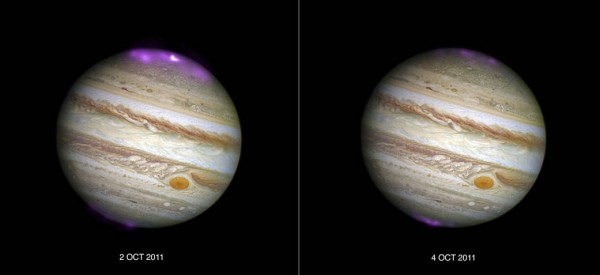By Ana Verayo, | March 24, 2016

Solar storms are triggering X-ray auroras on Jupiter that are about eight times brighter than normal over a large area of the planet and hundreds of times more energetic than Earth’s ‘northern lights,’ according to a new study using data from NASA’s Chand
The Northern Lights or the Aurora borealis are not only a novel, brilliant sky event on Earth as Jupiter also possesses multiple aurorae inside its dense atmosphere. However, unlike those on Earth, Jupiter's brilliant light displays can only be visible through X-rays.
NASA's Juno mission just released new images of Jupiter revealing incredible, massive aurorae from composite images. These stunning lights in the alien world was captured by the Chandra X-ray Observatory back in 2011, as astronomers study Jupiter's auroras for the first time ever in X-ray light.
Like Us on Facebook
Here on Earth, the Northern Lights are generated when charged energy particles from the sun known as coronal mass ejections (CMEs) crash onto the magnetic field of the planet known as the magnetosphere where stellar winds and the Earth's magnetic field merge.
When these solar winds have entered the magnetosphere, the magnetic field shields the planet and directs these particles towards the polar regions as they collide with gas atoms in the atmosphere, producing bright light emissions that are linked with auroras. For example, oxygen produces green colors in an aurora while nitrogen makes blue or red colors.
However, on Jupiter, solar winds that are transporting these coronal mass ejections, compress the magnetosphere of Jupiter that shifts the the boundary between its magnetic field and atmosphere inward for more than a million miles. This can generate energetic X-rays on Jupiter's aurorae that cover areas that are larger than the surface of Earth.
Scientists say that the impact of these CMEs on Jupiter's auroras was tracked upon monitoring the X-rays that were emitted after two 11 hour observations. Scientists have analyzed this data in order to detect the source of this X-ray activity and identify the areas at different occurring times.
The Juno spacecraft was launched in 2011 which is now en route to Jupiter, that will reach polar orbit in July. The mission aims to study Jupiter and its lunar system, along with the planet's history and evolution, leading to more insight about how the solar system formed.
This new study is published in the Journal of Geophysical Research Space Physics.
-
Use of Coronavirus Pandemic Drones Raises Privacy Concerns: Drones Spread Fear, Local Officials Say

-
Coronavirus Hampers The Delivery Of Lockheed Martin F-35 Stealth Fighters For 2020

-
Instagram Speeds Up Plans to Add Account Memorialization Feature Due to COVID-19 Deaths

-
NASA: Perseverance Plans to Bring 'Mars Rock' to Earth in 2031

-
600 Dead And 3,000 In The Hospital as Iranians Believed Drinking High-Concentrations of Alcohol Can Cure The Coronavirus

-
600 Dead And 3,000 In The Hospital as Iranians Believed Drinking High-Concentrations of Alcohol Can Cure The Coronavirus

-
COVID-19: Doctors, Nurses Use Virtual Reality to Learn New Skills in Treating Coronavirus Patients







